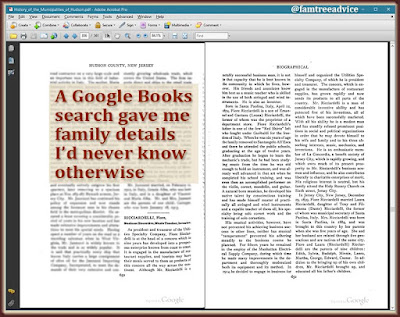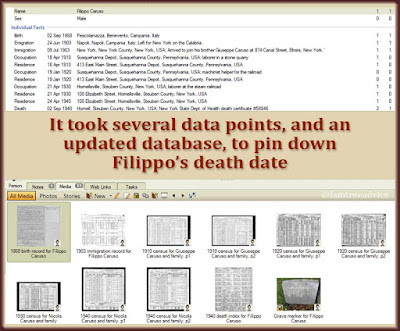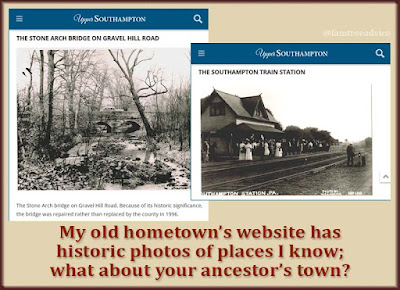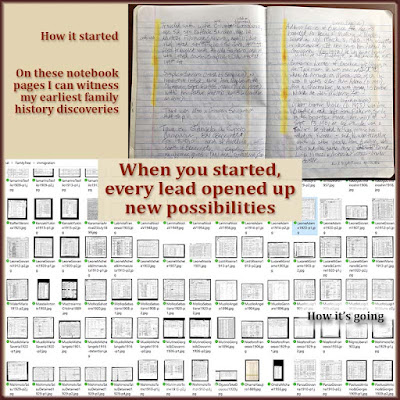How much can you ever know about your peasant ancestors? I spend all my time reading 19th-century vital records from a handful of rural Italian towns. Most records contain X's instead of signatures because almost everyone was illiterate.
In places like these, you can't expect to find your ancestors in the local society pages. No one could read, so there wouldn't be a need for such newspaper coverage. All you have are birth, marriage, and death records. Well, almost.
You can find some general local history about your ancestral towns. Last week I wrote about using Google Books to learn more about the places where your ancestors lived. You may find a good reference book in a library, too.
Without published stories, what can you learn about your family from vital records and a book or two? Here are examples from my extended family tree.
Successful Man Suffers Many Losses
 |
| When you find every available vital record for a family in your tree, you'll begin to see a snapshot of their lives. |
Nicolangelo Nista was born in 1788 in my ancestral hometown of Colle Sannita, Italy. Piecing together the vital records for his immediate family, I discovered:
- His first wife and two of their daughters died on August 2, August 7, and August 9, 1834. The dates make it reasonable to think a sickness was going through the town at the time. That year saw many more deaths than the surrounding years.
- Four of his other children had already died before 1834.
- His wife's death left Nicolangelo with six children to raise, ranging in age from 18 to two years old.
- He married a younger widow the following year.
- They had four children together, two of whom died in infancy.
- His sister Nicolina was luckier in life, despite dying at the age of 46. She had at least two children who grew up, married, raised a family, and outlived her.
- His brother Giovanni became a priest and lived to be 78 years old.
- Nicolangelo lived to be more than 72 years old. The available death records for the town end in 1860, and Nicolangelo was still alive.
- He was a proprietario—an owner of property or a business. Despite his losses, Nicolangelo is likely to have lived a comfortable life.
Earthquake Hits Home
The same town of Colle Sannita has suffered several earthquakes. The 1962 earthquake damaged my grandfather's childhood home so badly, they had to demolish it. On my second visit to Grandpa's town, my cousins showed me the stone front doorstep. It was all that remained of his home.
I have a list of the 40 victims of an earthquake in Colle Sannita way back on 26 July 1805. Civil records for the town begin in 1809, yet I've managed to place a few of the victims in my family tree. One of them was my 38-year-old 5th great grandaunt, Libera Nigro.
 |
| See how one piece of local history from your ancestral hometown can add very real context to your family tree. |
Libera and her husband Giovanni had three daughters that I've found. Sadly, Libera and two of her daughters, ages four and five, died in the 1805 earthquake. Without that list of victims, I would have no record of little Grazia and Anna Maria, my 1st cousins 6 times removed.
Suffering and Serendipity
I love to put entire families together from my ancestral hometowns. In doing so, I often see cases of several children dying young in the same family. It's so sad to see a couple name their baby Giuseppe, for example, only to have him die so soon. They name the next son Giuseppe, and he dies young. Then they name the next one Giuseppe. Each time I see this happen, I say, "That's a doomed name for them."
It also makes me sad to see a husband and wife die on the same day or a few days apart. These death records don't include a cause of death, but we may assume they died of the same cause. Maybe they both caught the flu or had some sort of accident.
One thing I noticed years ago always makes me laugh. You see, most of the old-country Italians in my family tree were poor. They usually gave their children one or two first names. For example, my 5th great grandparents named one son Angelo, and the other Tommaso Antonio.
Sometimes I find a well-to-do family. What's funny is that these richer families often give their children four or five first names. One such family named their children:
- Angela Maria Lorenza
- Maria Luisa Barbara Margarita
- Maria Amalia Carmela Camilla
- Domenico Maria (he got short-changed)
- Francesco Saverio Gaetano Achille
- Carolina Maria Vincenza
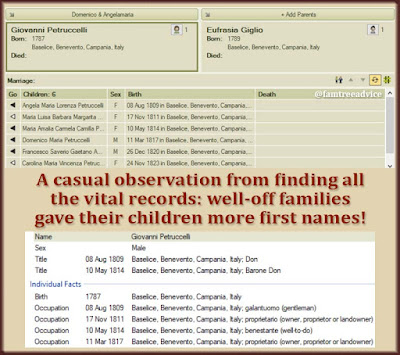 |
| Pay attention to each detail from vital records. You may find common patterns like this. |
Their father had the honorary titles of Don and Baron. At different times his occupation was landowner (proprietario), gentleman (galantuomo), or well-to-do (benestante). I always joke that these families were rich enough to afford more names for their babies.
The keys to developing a profile from vital records are:
- Find every available vital record for the immediate family.
- Notice the timing of events.
- Search for historical points of interest, like earthquakes, famine, disease, and war.
What stands out about your ancestors' vital records?
And speaking of vital records:
